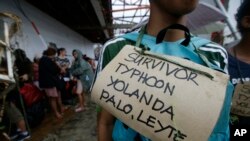MANILA —
The Philippine government is still contending with the confusion and difficulty of sending aid across the typhoon-devastated central part of the country. But five days after Super Typhoon Haiyan tore through, killing more than 2,200, people, authorities say more airports are opening up as well as major roads.
At the entrance of the Villamor Air Force Base in Manila, Adelyn Maño huddled with dozens of people at a bus stop as a rainstorm passed through. She had just arrived from Tacloban, one of the hardest hit cities.
“I came with them, my three children and a companion. And my other child, she died because the water went up so high, she lamented, "she was not even buried because there are no coffins there.”
Typhoon Haiyan brought a storm surge five meters high that slammed Tacloban and left countless people dead in its wake.
Maños said her family was forced to come to Manila because of a lack of food. She said they waited in line at the airport for two days without anything to eat or drink.
The Tacloban airport has been a rally point for getting aid to the worst hit regions, but blocked roads have slowed deliveries to Samar Province and other towns in the east.
Authorities reported progress Tuesday in clearing debris from major highways and reopening airports in other areas that have been badly hit.
Although the international community is sending in money, relief goods and military assets, Presidential Cabinet Secretary Rene Almendras told reporters in Manila that coordination remains a challenge.
“There has never been anything at the magnitude of what we are trying to do now," Almendras said. "Not in size, not in volume, not in- even the breadth of it. The logistics alone, we discussed over two hours last night, talking about how to move goods, where to move goods, how many trucks you need, even from packing center to shipping center.”
The government has made Cebu, a central island with some badly-ravaged towns, the main receiving hub for all international aid. Officials say all national roads in and out of Leyte, Samar and nearby Biliran Islands are open. Provincial bus service to the region started running Wednesday.
According to the Civil Defense office, about 600,000 people remain displaced, with close to half staying at evacuation centers.
With aid workers focused on helping survivors, what to do with the dead is another matter. Almendras said some locations do not have enough body bags.
The coordination struggles between the central and local governments are also reflected in varying death tolls. The national government has confirmed about 2,000 deaths, but some regional and local governments have larger counts.
Presidential Cabinet Secretary Almendras said the government’s goal is to have a well-run system in place in the coming days.
At the entrance of the Villamor Air Force Base in Manila, Adelyn Maño huddled with dozens of people at a bus stop as a rainstorm passed through. She had just arrived from Tacloban, one of the hardest hit cities.
“I came with them, my three children and a companion. And my other child, she died because the water went up so high, she lamented, "she was not even buried because there are no coffins there.”
Typhoon Haiyan brought a storm surge five meters high that slammed Tacloban and left countless people dead in its wake.
Maños said her family was forced to come to Manila because of a lack of food. She said they waited in line at the airport for two days without anything to eat or drink.
The Tacloban airport has been a rally point for getting aid to the worst hit regions, but blocked roads have slowed deliveries to Samar Province and other towns in the east.
Authorities reported progress Tuesday in clearing debris from major highways and reopening airports in other areas that have been badly hit.
Although the international community is sending in money, relief goods and military assets, Presidential Cabinet Secretary Rene Almendras told reporters in Manila that coordination remains a challenge.
“There has never been anything at the magnitude of what we are trying to do now," Almendras said. "Not in size, not in volume, not in- even the breadth of it. The logistics alone, we discussed over two hours last night, talking about how to move goods, where to move goods, how many trucks you need, even from packing center to shipping center.”
The government has made Cebu, a central island with some badly-ravaged towns, the main receiving hub for all international aid. Officials say all national roads in and out of Leyte, Samar and nearby Biliran Islands are open. Provincial bus service to the region started running Wednesday.
According to the Civil Defense office, about 600,000 people remain displaced, with close to half staying at evacuation centers.
With aid workers focused on helping survivors, what to do with the dead is another matter. Almendras said some locations do not have enough body bags.
The coordination struggles between the central and local governments are also reflected in varying death tolls. The national government has confirmed about 2,000 deaths, but some regional and local governments have larger counts.
Presidential Cabinet Secretary Almendras said the government’s goal is to have a well-run system in place in the coming days.







